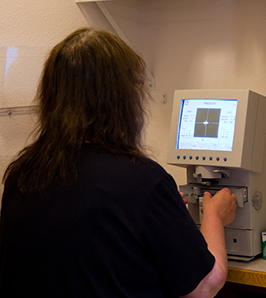 We know how to fit glasses, we are not just taking your order. The first step we take is to look and understand the eyeglass prescription. There are many types of lenses: single vision, lined bifocal, lined trifocal, progressive (no-line bifocal). We take the time to look at a patient’s face shape to select frames which are suitable and fashionable. We always ask if they prefer metal, plastic or rimless frames.
We know how to fit glasses, we are not just taking your order. The first step we take is to look and understand the eyeglass prescription. There are many types of lenses: single vision, lined bifocal, lined trifocal, progressive (no-line bifocal). We take the time to look at a patient’s face shape to select frames which are suitable and fashionable. We always ask if they prefer metal, plastic or rimless frames.
It is also necessary to understand lens material so lenses are as thin and attractive as possible. As we are fitting progressive lenses, we keep in mind all the different types of progressive lenses so that we have the proper placement over your progressive lenses. Many offices do not keep this complexity in mind and therefore you do not get the full power (strength) of the reading portion. The bottom portion of a +2.50 add may be cut off so you only realize a reduced add of say +1.75. This is fairly common error in the fitting of no-line bifocals. We always fit and measure to avoid this error. And unlike some offices who use cheaper-quality generic no-line bifocals, we use only brand name quality like Varilux.
It is the practice of some chain store or big box opticals to fit frames from their own inventory, which can cause substitution. Every frame has a certain bridge size, eye size, temple size and color so a single frame can have 20-40 variations. If you need a 140 temple length for a proper fit, but all they have in stock is 145, then you will get the 145 because they are committed to sell from their inventory, even though it is too long and your glasses will slide forward. This will never happen in our office because we always order the correct 140 length directly from the manufacturer, unused and never worn. We never Substitute.
Plastic frames must fit perfectly on the nose. As we are fitting we always keep in mind the temple length so your glasses stay in place. Metal allergies can be a problem so we have Stainless Steel, Titanium and Plastic options. In Dr. Wieber’s office we fit you with frames so that you can see and look the best.
We have special instrumentation so we can accurately check out every pair of glasses to make sure that the prescription is correct. This is not routinely done any more in many offices.

Rita is measuring Tammy's "PD"(Pupillary Distance) using a Digital Corneal Reflection Pupillometer which accurately measures the distance from the center bridge of the nose to the center of the eye for each eye. The right and left are often different and this is important, especially in the fitting of no-line bifocals.

The printout under Rita's left hand is matched against the original doctor's prescription to make sure it is accurate. Sadly, our experience indicates very few offices check this anymore. It is noteworthy that some glasses are made incorrectly, and without this final check, they would be dispensed to the patient. But not from our office using this Fail-Safe system to detect wrong glasses.
